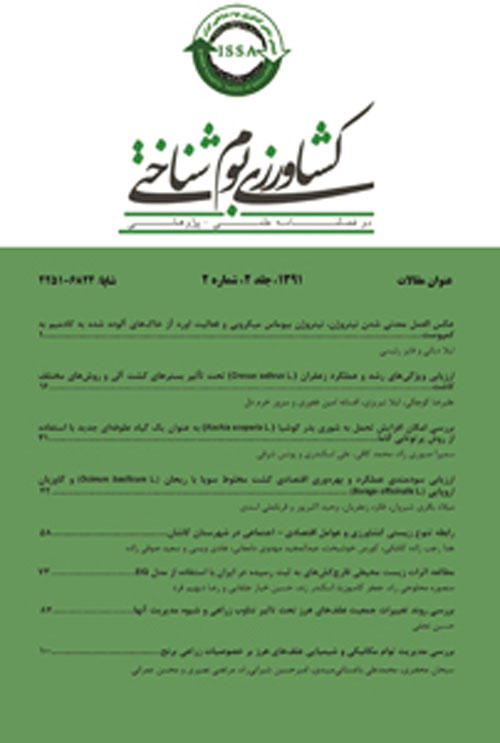Evaluation the effect of different planting combinations on radiation absorption and use efficiency in sesame and chickpea intercropping in an additive series
Author(s):
Abstract:
Introduction
In the modernization of crop production, most methods used by growers to achieve better yields have largely been explored. Most of these methods involve increasing the efficiency of the utilization of natural resources. A rise in radiation use efficiency is one of the major criteria for obtaining a yield advantage. Plant dry matter accumulation has a linear relationship with accumulative Photosynthetically Active Radiation (PAR). Intercropping could be a strategy for increasing light absorption in agronomic systems and may improve radiation use efficiency (RUE): The additional solar energy used by the intercrop canopy leads to improved crop production and, thus, greater economic yield. Over the past three decades, there has been much study on the uses of radiation in intercropping and alley cropping systems for a wide range of crop combinations (Zhang et al., 2008; Sinclair and Muchow, 1999). However, the association of sesame and chickpea had not been analysed until now.Materials And Methods
This study was conducted in order to evaluate radiation absorption and use efficiency in replacement series intercropping of chickpea and sesame. The treatments were arranged in split plots based on a randomized complete block design with three replications. The treatments consisted of two planting methods, namely row planting and mixed planting (as main plot) and five planting ratios including chickpea monoculture, sesame monoculture, 10% chickpea흍% sesame, 20% chickpea흍% sesame, 30% chickpea흍% sesame as sub plot. Results And Discussion
Results showed that sesame RUE was higher than chickpea RUE in all the treatments. The amount of sesame RUE varied from 1.49 to 1.76 g MJ-1 PAR and from 1 to 1.27 g MJ-1 PAR in row planting and mixed planting, respectively. The amount of chickpea RUE, also varied from 1.02 to 1.1 g MJ-1 PAR and from 0.71 to 0.94 g MJ-1 PAR in row planting and mixed planting, respectively. The results also showed that sesame RUE in intercropping treatments was higher than in monocropping treatments, but chickpea RUE in intercropping treatments was higher than in simply monocropping in row planting. In general, the amount of RUE of both crops in row planting was higher than in mixed planting, either in intercropping or monocropping treatments. Based on these results the best recommendable treatment for intercropping is 100% sesame% chickpea based on row planting. The chickpea RUE for treatment of 100% sesame% chickpea based on row planting was the highest level (1.1 g MJ-1) among the other treatments and the sesame RUE of this treatment was higher than the sesame monocrop RUE (1.7 g MJ-1 vs. 1.49 g MJ-1 in monocrop). The main findings in this study were as follows: Firstly, the intercrop intercepted more PAR than sesame and chickpea alone. Secondly, sesame/chickpea intercropping utilized radiant energy more efficiency than the monocrop, and sesame alone had greater RUE than chickpea alone. The higher ratio of diffuse to direct radiation surrounding the intercrop peanut would help to improve its e value (Sinclair et al., 1999). The shading effect offered by the taller plant might be partially offset by its higher photosynthetic rates per unit PAR at low intensity (Sinclair et al., 1989, Tsubo et al., 2001). Conclusion
The results showed that chickpea plants can tolerate the shade produced by sesame plants when grown as a row intercrop but not under mixed intercrop. The higher yields obtained in intercropping systems are probably due to greater radiation-use efficiencies. Chickpea RUE decreased under mixed cropping, for the reason that raised sesame produced shading on chickpea. Keywords:
Language:
Persian
Published:
Journal of Agroecology, Volume:6 Issue: 1, 2016
Page:
81
https://magiran.com/p1586442
دانلود و مطالعه متن این مقاله با یکی از روشهای زیر امکان پذیر است:
اشتراک شخصی
با عضویت و پرداخت آنلاین حق اشتراک یکساله به مبلغ 1,390,000ريال میتوانید 70 عنوان مطلب دانلود کنید!
اشتراک سازمانی
به کتابخانه دانشگاه یا محل کار خود پیشنهاد کنید تا اشتراک سازمانی این پایگاه را برای دسترسی نامحدود همه کاربران به متن مطالب تهیه نمایند!
توجه!
- حق عضویت دریافتی صرف حمایت از نشریات عضو و نگهداری، تکمیل و توسعه مگیران میشود.
- پرداخت حق اشتراک و دانلود مقالات اجازه بازنشر آن در سایر رسانههای چاپی و دیجیتال را به کاربر نمیدهد.
In order to view content subscription is required
Personal subscription
Subscribe magiran.com for 70 € euros via PayPal and download 70 articles during a year.
Organization subscription
Please contact us to subscribe your university or library for unlimited access!


